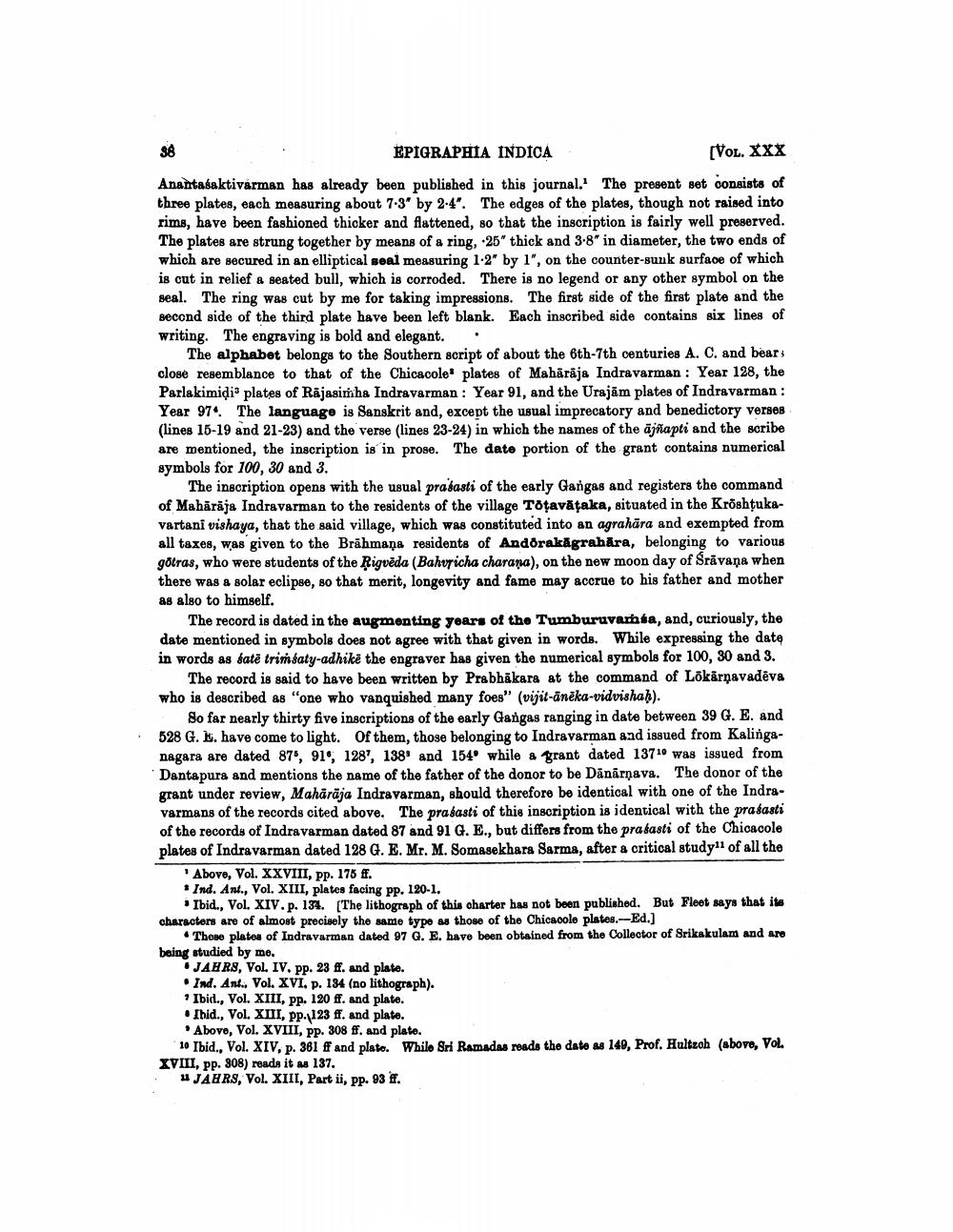________________
38
.
EPIGRAPHIA INDICA
(VOL. XXX
Anantasaktivarman has already been published in this journal.' The present set consists of three plates, each measuring about 7-3' by 2-4". The edges of the plates, though not raised into rims, have been fashioned thicker and flattened, so that the inscription is fairly well preserved. The plates are strung together by means of a ring, .25" thick and 3-8" in diameter, the two ends of which are secured in an elliptical seal measuring 1.2" by 1", on the counter-sunk surface of which is cut in relief a seated bull, which is corroded. There is no legend or any other symbol on the seal. The ring was cut by me for taking impressions. The first side of the first plate and the second side of the third plate have been left blank. Each inscribed side contains six lines of writing. The engraving is bold and elegant. .
The alphabet belongs to the Southern script of about the 6th-7th centuries A. C. and bear close resemblance to that of the Chicacole plates of Mahārāja Indravarman : Year 128, the Parlakimidi plates of Rajasimha Indravarman : Year 91, and the Urajām plates of Indravarman : Year 97. The language is Sanskrit and, except the usual imprecatory and benedictory verses (lines 16-19 and 21-23) and the verse (lines 23-24) in which the names of the ajñapti and the scribe are mentioned, the inscription is in prose. The date portion of the grant contains numerical symbols for 100, 30 and 3.
The inscription opens with the usual prasasti of the early Gangas and registers the command of Mahārāja Indravarman to the residents of the village Tötavăţaka, situated in the Kröshtukavartani vishaya, that the said village, which was constituted into an agrahāra and exempted from all taxes, was given to the Brāhmaṇa residents of Andorakāgrahāra, belonging to various gotras, who were students of the Rigvēda (Bahvricha charana), on the new moon day of Srāvana when there was a solar eclipse, so that merit, longevity and fame may accrue to his father and mother as also to himself.
The record is dated in the augmenting years of the Tumburuvamia, and, curiously, the date mentioned in symbols does not agree with that given in words. While expressing the date in words as satë trimsaty-adhikë the engraver has given the numerical symbols for 100, 30 and 3.
The record is said to have been written by Prabhākara at the command of Lökārņavadēva who is described as "one who vanquished many foes" (vijit-anēka-vidvishah).
So far nearly thirty five inscriptions of the early Gangas ranging in date between 39 G. E. and 528 G. E. have come to light. Of them, those belonging to Indravarman aad issued from Kalinganagara are dated 875, 919, 128, 138 and 154' while a grant dated 1370 was issued from Dantapura and mentions the name of the father of the donor to be Dānārņava. The donor of the grant under review, Mahārāja Indravarman, should therefore be identical with one of the Indravarmans of the records cited above. The prasasti of this inscription is identical with the prasasti of the records of Indravarman dated 87 and 91 G. E., but differs from the prasasti of the Chicacole plates of Indravarman dated 128 G. E. Mr. M. Somasekhara Sarma, after a critical study of all the
"Above, Vol. XXVIII, pp. 175 ff. * Ind. Ant., Vol. XIII, plates facing pp. 120-1.
Ibid., Vol. XIV. p. 134. The lithograph of this charter has not been published. But Fleet says that its characters are of almost precisely the same type as those of the Chicacole plates.-Ed.]
• Those plates of Indravarman dated 97 G. E. have been obtained from the Collector of Srikakulam and are being studied by me.
JAHRS, VOL. IV. Pp. 23 ff. and plate. . Ind. Ant. Vol. XVI. p. 134 (no lithograph). * Ibid., Vol. XIII, pp. 120 ff. and plate. • Ihid., Vol. XIII, pp. 123 ff. and plate. . Above, Vol. XVIII, pp. 308 ff. and plate.
10 Ibid., Vol. XIV, p. 361 ff and plato. While Sri Ramadas reads the data as 149, Prof. Hultzoh (above, Vol. XVIII, pp. 808) reada it as 137.
UJAHRS, Vol. XIII, Part ii, pp. 93 ff.




